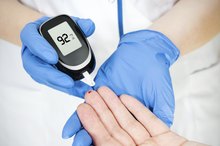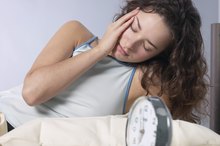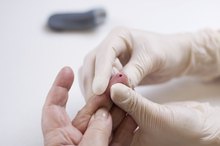About Dangerous Levels of Blood Sugar
Diabetes, characterized by fasting glucose (blood sugar) levels above 120, generally requires oral medication or insulin injections to control glucose levels. Changes in diet and exercise assist the body in maintaining appropriate levels of blood sugar throughout the day. However, even with proper treatment and good control of glucose, people with diabetes run the risk of hypoglycemia (low blood sugar) or hyperglycemia (high blood sugar).
Types
Hypoglycemia occurs when blood sugar levels drop below 70, and may occur as a result of skipping a meal, forgetting to eat a snack or simply failing to consume enough carbohydrates to maintain an adequate level of glucose. Strenuous exercise or illness may bring on hypoglycemia. Medications used to treat diabetes sometimes cause a drop in blood sugar in the middle of the night. Hyperglycemia occurs when glucose levels of 200 to 240 or more, depending on the target range for the individual. Generally, a sudden spike in glucose after meals begins to come down within an hour or two after eating, but when glucose levels fail to drop, or continue to climb, hyperglycemia causes concern. Eating too large a meal or a meal containing large amounts of carbohydrates, lack of exercise or stress and illness contribute to high blood glucose levels.
- Hypoglycemia occurs when blood sugar levels drop below 70, and may occur as a result of skipping a meal, forgetting to eat a snack or simply failing to consume enough carbohydrates to maintain an adequate level of glucose.
- Eating too large a meal or a meal containing large amounts of carbohydrates, lack of exercise or stress and illness contribute to high blood glucose levels.
Features
What Are the Blood Sugar Levels for Diabetes?
Learn More
Symptoms of hypoglycemia (low blood sugar) include pale skin, jitters or shakiness, the feeling of extreme hunger, headache, dizziness, changes in behavior or mood, difficulty paying attention or confusion or tingling around the mouth. Symptoms of hyperglycemia include excessive thirst and increased urination. Blood glucose readings above 200 indicate that hyperglycemia requires treatment. At levels of 240 or more, the risk of diabetic coma (ketoacidosis) exists.
- Symptoms of hypoglycemia (low blood sugar) include pale skin, jitters or shakiness, the feeling of extreme hunger, headache, dizziness, changes in behavior or mood, difficulty paying attention or confusion or tingling around the mouth.
- Symptoms of hyperglycemia include excessive thirst and increased urination.
Effects
Ketoacidosis develops when the body has inadequate amounts of insulin to process glucose and begins to break down fat for fuel. This process creates keotones that cannot be tolerated by the body. Keotones are deposited in the urine in the body's attempt to rid itself of excessive amounts of keotones. Because the body cannot release all the keotones, they build up in the bloodstream and lead to ketoacidosis referred to as diabetic coma.
- Ketoacidosis develops when the body has inadequate amounts of insulin to process glucose and begins to break down fat for fuel.
- Because the body cannot release all the keotones, they build up in the bloodstream and lead to ketoacidosis referred to as diabetic coma.
Prevention/Solution
Signs & Symptoms Hypoglycemia & Hyperglycemia
Learn More
Treatment of low blood sugar consists of consuming carbohydrates to bring the level up. Sugary drinks like ½ cup of juice or regular soft drink, glucose tablets or hard candies generally produce the desired results. Check the glucose level in 15 minutes, if glucose levels are still low; repeat the process every 15 minutes until the desired results are reached. Maintain a regular schedule of meals and snacks. Treatment of high blood sugar requires exercise, as long as the person is not producing keotones in the urine. A simple urine test determines if keotones are present. Patients at risk of hyperglycemia should keep a supply of testing material for checking for keotones. Check with your doctor for his advice. If keotones are not present in the urine, exercise immediately to bring blood sugar levels down. Exercising when keotones are present in the urine produces an inverse effect and raises blood sugar even higher.
- Treatment of low blood sugar consists of consuming carbohydrates to bring the level up.
Warning
Seek you doctor's advice for target levels of healthy blood sugar and instructions for treating hyperglycemia. Adjustments in medication may be necessary to maintain a healthy glucose level. This information is presented for educational purposes only and should not be substituted for medical advice.
- Seek you doctor's advice for target levels of healthy blood sugar and instructions for treating hyperglycemia.
- This information is presented for educational purposes only and should not be substituted for medical advice.
Related Articles
References
- Managing your blood sugar: MedlinePlus Medical Encyclopedia. MedlinePlus. May 17, 2018.
- Mouri M, Badireddy M. Hyperglycemia. Treasure Island, Fl: StatPearls Publishing; 2019.
- Okano J, Kojima H, Katagi M, et al. Hyperglycemia Induces Skin Barrier Dysfunctions with Impairment of Epidermal Integrity in Non-Wounded Skin of Type 1 Diabetic Mice. PLoS ONE. 2016;11(11):e0166215. doi:10.1371/journal.pone.0166215
- Maiorino MI, Bellastella G, Esposito K. Diabetes and sexual dysfunction: current perspectives. Diabetes Metab Syndr Obes. 2014;7:95-105. doi:10.2147/DMSO.S36455
- Mirghani dirar A, Doupis J. Gestational diabetes from A to Z. World J Diabetes. 2017;8(12):489-511. doi:10.4239/wjd.v8.i12.489
- Family Health History and Diabetes | CDC. Centers for Disease Control and Prevention. Jul 18, 2017.
- Farrar D. Hyperglycemia in pregnancy: prevalence, impact, and management challenges. Int J Womens Health. 2016;8:519-527. doi:10.2147/IJWH.S102117
- Goyal N, Kaur R, Sud A, Ghorpade N, Gupta M. Non Diabetic and Stress Induced Hyperglycemia [SIH] in Orthopaedic Practice What do we know so Far?. J Clin Diagn Res. 2014;8(10):LH01-3. doi:10.7860/JCDR/2014/10027.5022
- Riddell M, Perkins BA. Exercise and glucose metabolism in persons with diabetes mellitus: perspectives on the role for continuous glucose monitoring. J Diabetes Sci Technol. 2009;3(4):914-23. doi:10.1177/193229680900300439
- Sari MI, Sari N, Darlan DM, Prasetya RJ. Cigarette Smoking and Hyperglycaemia in Diabetic Patients. Open Access Maced J Med Sci. 2018;6(4):634-637. doi:10.3889/oamjms.2018.140
- Medagama AB. The glycaemic outcomes of Cinnamon, a review of the experimental evidence and clinical trials. Nutr J. 2015;14:108. doi:10.1186/s12937-015-0098-9
- Pramlintide Injection: MedlinePlus Drug Information. MedlinePlus. July 15, 2018.
- U.S. Food and Drug Administration. FDA Alerts Patients and Health Care Professionals to Nitrosamine Impurity Finding in Certain Metformin Extended-Release Products. May 28, 2020
- American Diabetes Association. High Blood Glucose. Mar 21, 2017.
- Mayo Clinic. Hyperglycemia in Diabetes. Apr 18, 2015.
- MedlinePlus. Metformin. Mar 15, 2020.
- National Institute of Diabetes and Digestive and Kidney Diseases. The A1CTest & Diabetes. Apr 2018.
Writer Bio
Nannette Richford is an avid gardener, teacher and nature enthusiast with more than four years' experience in online writing. Richford holds a Bachelor of Science in secondary education from the University of Maine Orono and certifications in teaching 7-12 English, K-8 General Elementary and Birth to age 5.









